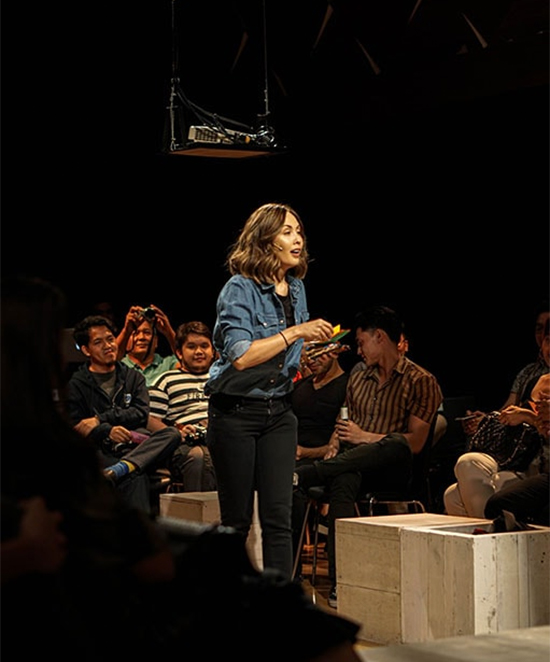The Sandbox Collective’s ‘Every Brilliant Thing’ is no less luminescent the second time around
When you walk into the Zobel de Ayala Recital Hall of the Maybank Performing Arts Theater to watch Duncan Macmillan’s Every Brilliant Thing, it’s hard to know what to expect. Bits gathered from social media and descriptions of the show will tell you that it’s an interactive one-woman play about mental health, but that’s about it.
Right before the show starts, as the audience members take their seats around the stage in the center of the room, pieces of paper are passed around, written with various words and phrases and a corresponding number. At this point, as the lights dimmed, I was just confused. And then the show starts.
Originally staged by The Sandbox Collective in 2019, EBT is back for the collective’s Sandbox Fest 2020, in which it runs alongside Lungs (also by Duncan Macmillan). Here, Teresa Herrera stars as a (usually unnamed) young girl who starts compiling a random list of everything she thinks is “brilliant” in the world.

In some shows, Kakki Teodoro plays the lead role. Some examples from the list include: 1) ice cream, 2) water fights, 3) staying up past your bedtime and being allowed to watch TV, and so on. She writes the list in the hope of cheering up her mom, who suffers from clinical depression. It doesn’t really change anything, she says, but she knows her mom read it because it came back with spelling corrections.
As she reads out the list, members of the audience who received a piece of paper are asked to read theirs out loud, which has a number that corresponds to an item on the list. But that’s not all that’s interactive about it. As the show goes on, audience members are asked to play characters like the veterinarian and the character’s guidance councilor, et cetera.
The play’s story follows Teresa’s character throughout her life, dealing with her relationship with her parents. It’s never explicitly stated, not in the beginning at least, that the character’s mom is depressed.
This part of the show is quite entertaining to watch and oftentimes tempers the show’s serious topics, but in a way that still keeps the integrity of the scene’s gravity.
For example, when the character’s mom is taken to the hospital for a suicide attempt, Teresa enlists an audience member to stand in while she plays her dad driving them to the hospital. The audience member can only reply to everything the dad says with a single word, “Why?”
The play’s story follows Teresa’s character throughout her life, dealing with her relationship with her parents. It’s never explicitly stated, not in the beginning at least, that the character’s mom is depressed. In the car ride to the hospital, all the father says is that her mom “did something stupid.”
There’s a lot of reading between the lines, but I guess that’s how you would tell a seven-year-old that Mom tried committing suicide, anyway. Like the rest of the play that follows, it feels real and true to life.
As the character grows older, so does the list, almost becoming its own character. However, the references in the list — and the play, by extension — leans heavily into American pop culture, which can be a little off-putting for something staged in Manila today.

It’s not obvious until the character gets to high school, where she declares her crush on ’90s Andre Agassi. I hear Kakki’s version has more local flavor, but this isn’t a dig at Teresa — playing to your strengths and your own experiences is always better than fumbling at an attempt to be locally relevant. (According to her website, Teresa lives between LA and Manila.)
And it pays off — despite the character coming from what seems to be an upper middle-class family, living in a nice house with a pool, a car and money for college, she remains relatable and authentic. And that’s when it hits you: this is a story that can happen (and does happen) to anyone.
However, there’s not a lot that’s said about the mother’s depression, and we only see it manifest in how the character and the father deal with it. The real meat, I think, comes when the character realizes later in life, that she too might have become depressed and needs to deal with her trauma.
In a full-circle moment, at the height of her self-realization, the character calls up her childhood guidance counselor. Earlier in the play, the guidance counselor has a sock puppet that helps comfort the character, and it returns for a phone call with the character when she’s an adult.
This would be totally weird if it happened IRL — and the character acknowledges this — but it’s the critical part of the play where it tells us that it’s okay to ask for help. That there’s no shame in asking to talk to someone.
Afterwards, the character gets other people to contribute to her list, and it takes on a life of its own, reaching a million brilliant things. Right after watching the show I thought it didn’t really aim to have a lesson, that it was really just a realistic, authentic, relatable depiction of dealing with mental health, but as I think about it further, it hits: no matter how clichéd and cheesy it sounds, you are not alone.
Dealing with your demons is a lot better with people by your side, because the only way to get through it is to go through it.


